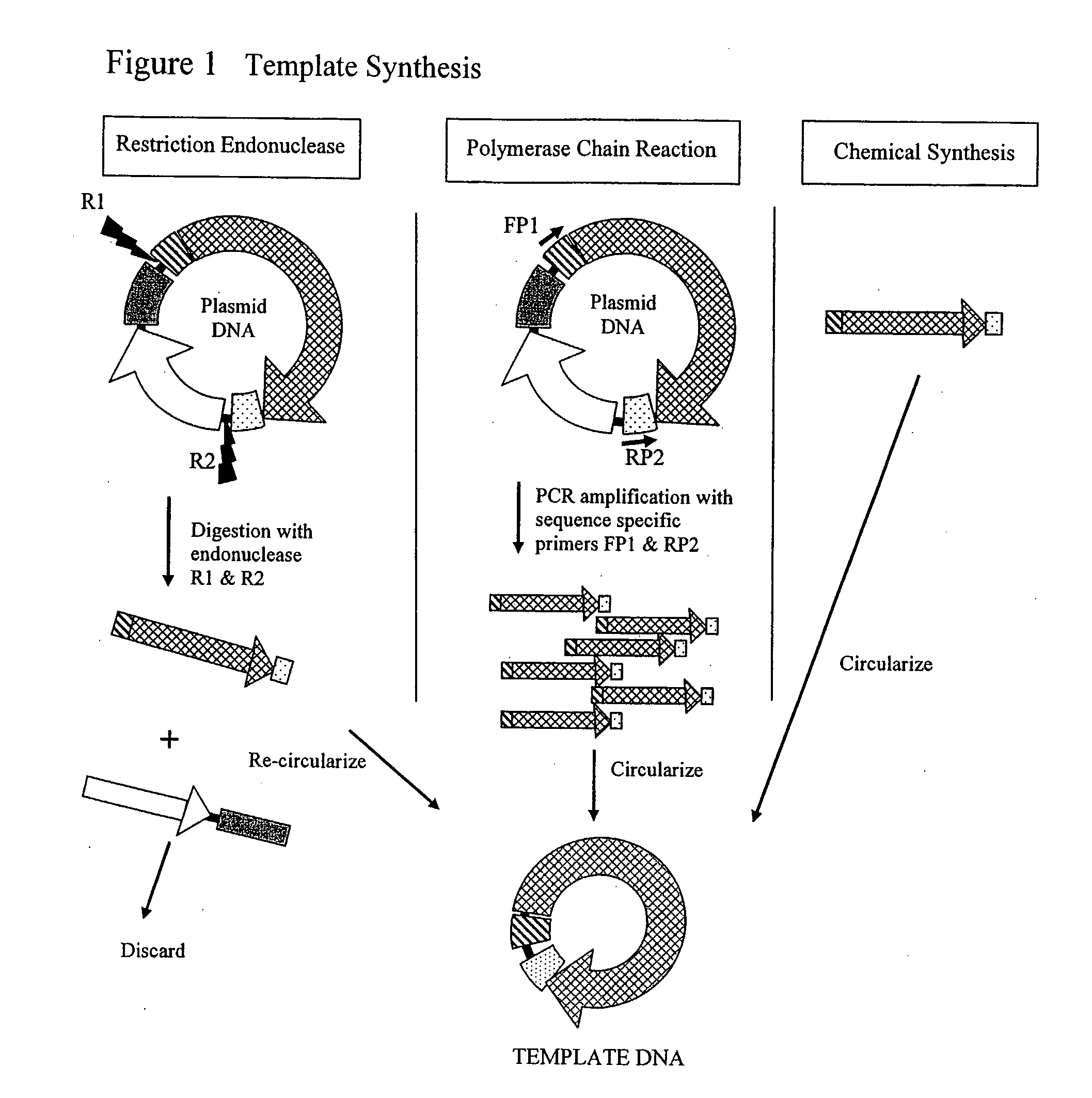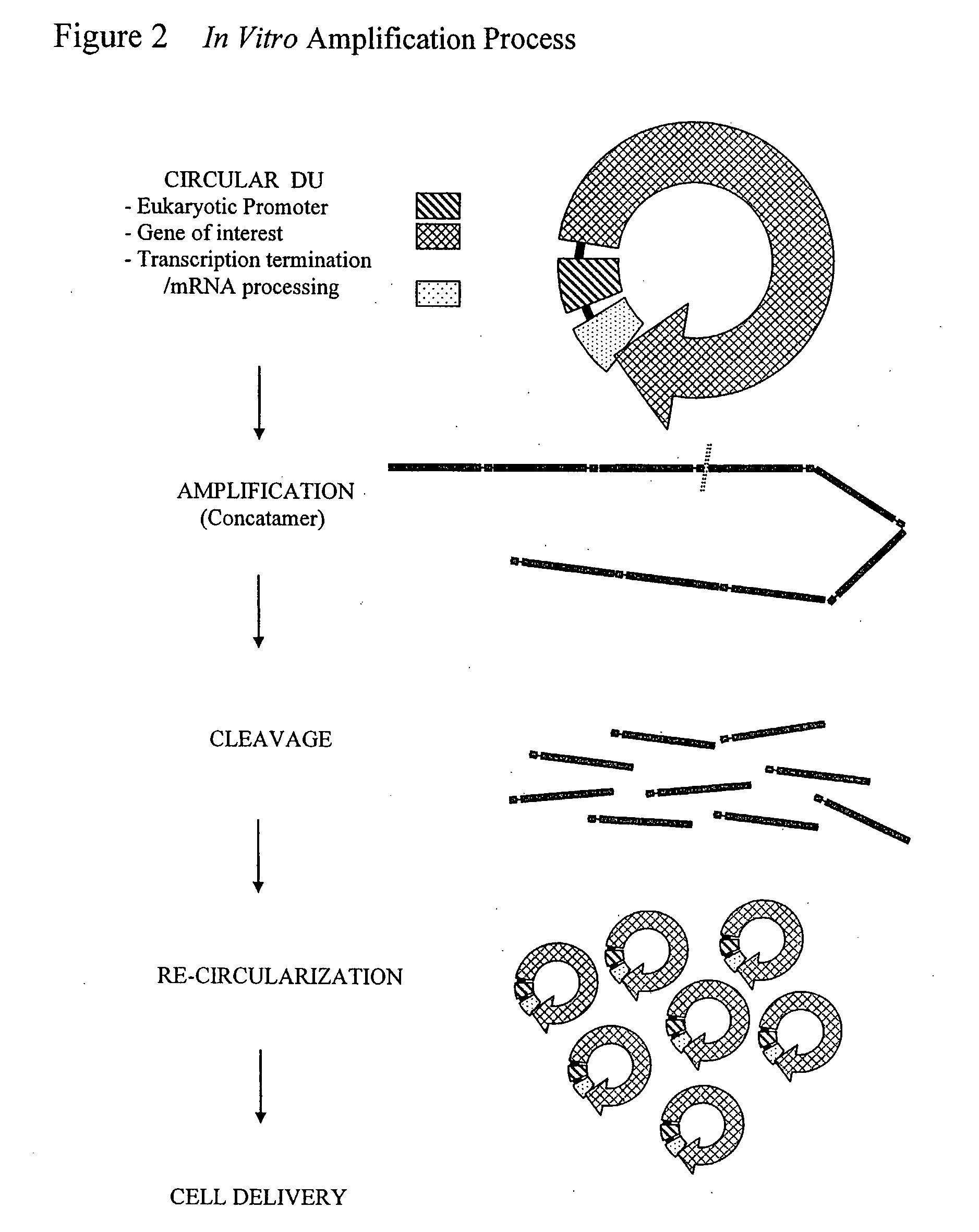Cell Free Biosynthesis of High-Quality Nucleic Acid and Uses Thereof
a nucleic acid and cell-free technology, applied in the field of high-quality nucleic acid production, to achieve the effects of facilitating rapid uptake, prolonging the lifespan of expression of the cassette once, and stabilizing or minimizing the degradation of the linear in vivo
- Summary
- Abstract
- Description
- Claims
- Application Information
AI Technical Summary
Benefits of technology
Problems solved by technology
Method used
Image
Examples
example 1
Synthesis and Cell Free Amplification of β-Galactosidase (LacZ-DU)
[0091]a) Plasmid-Based Template. pSV-β-Galactosidase vector (Promega Corp. Madison, Wis., USA) was partially digested with EcoR I and Pst I. A fragment of about 4.2 kb containing the CMV promoter, Lac Z ORF and SV40 small T antigen termination sequences (LacZ-DU) was isolated, blunt ended with T4 DNA polymerase and cloned into the Sma I site of pGEM™-7Zf(+) (Promega Corp. Madison, Wis., USA) creating the pGEM-LacZ-DU vector. The LacZ-DU was subsequently excised from pGEM-LacZ-DU with Xba I, gel purified, and circularized using T4 DNA ligase (New England Biolabs, Beverly, Mass., USA) as per manufacturer recommendations.
b) PCR-Based Template. LacZ-DU was amplified from the pVAX™200-GW / lacZ vector (Invitrogen Carlsbad, Calif., USA ) using forward (5′-CGGGATCCGACTCTTCGCGATG TAC-3′) and reverse (5′-CGGGATCCCAGCATGCCTGC-3′) primers containing the BamH I endonuclease recognition site. LacZ-DU was amplified in 50 μl reactions...
example2
Synthesis and Cell Free Amplification of Luciferase (Luc-DU)
[0092]The pGL3 vector (Promega Corp. Madison, Wis., USA) was digested with Sal I and Xho I. A fragment of about 2.17 kb containing the SV40 promoter, Luciferase ORF and SV40 small T antigen termination sequences (Luc-DU) was isolated, purified and re-circularized using T4 DNA ligase (Invitrogen, Carlsbad, Calif., USA) as per manufacturer recommendations.
a) Cell Free Amplification. Reactions containing hexamers 5′-ApApTpTpsGpsC-3′ and 5′-ApGpCpApsApsT-3′ at 400 pmol each and 10 ng / 25 μl reaction of circular Luc-DU were heated to 95° C. for 3 min in 40 mM Tris-HCl pH 8; 10 mM MgCl2 and cooled to room temperature. Phi29 DNA polymerase (10U, New England Biolabs, Beverly, Mass., USA); 1 mM dNTPs (25 / 25 / 25 / 25); 5% glycerol; 0.7 U yeast inorganic pyrophosphatase (Sigma, St. Louis, Mo., USA) and 100 μg / ml BSA were added. Amplification was carried out in 25 μl reaction at 30° C. in 50 mM Tris-HCl pH 7.5; 10 mM MgCl2; 10 mM (NH4)2SO4...
example 3
Expression of Amplified DNA in Human Cells
[0093]Human A549 lung carcinoma cells (ATCC) were cultured in Dulbecco's modified Eagle's medium (DMEM; Invitrogen Carlsbad, Calif., USA) supplemented with 10% heat-inactivated fetal bovine serum (Hyclone, Logan, Utah, USA), 100 U / ml penicillin, 100 μg / ml streptomycin (Invitrogen Carlsbad, Calif., USA) and incubated at 37° C. in 5% CO2 environment.
a) DNA Transfection. The day prior to transfection, A549 cells were seeded in 6-well plates at a density of 1×105 cells / ml. GenePORTER 2 transfection reagent (Gene Therapy System, San Diego, Calif., USA) was used for cell transfection as directed by manufacturer. Briefly, cell free amplified DU or parental plasmid DNA (Promega Corp. Madison, Wis., USA) were mixed with 2 μg of carrier pssXE DNA (Chen and McMicken, Gene Ther 10: 1776-1780, 2003) in 50 μl of DNA diluent B and incubated at room temperature for 5 min. DNA solution was then mixed with 7 μl of GenePORTER 2 reagent pre-diluted in 50 μl of ...
PUM
| Property | Measurement | Unit |
|---|---|---|
| body weight | aaaaa | aaaaa |
| volumes | aaaaa | aaaaa |
| volume | aaaaa | aaaaa |
Abstract
Description
Claims
Application Information
 Login to View More
Login to View More - R&D
- Intellectual Property
- Life Sciences
- Materials
- Tech Scout
- Unparalleled Data Quality
- Higher Quality Content
- 60% Fewer Hallucinations
Browse by: Latest US Patents, China's latest patents, Technical Efficacy Thesaurus, Application Domain, Technology Topic, Popular Technical Reports.
© 2025 PatSnap. All rights reserved.Legal|Privacy policy|Modern Slavery Act Transparency Statement|Sitemap|About US| Contact US: help@patsnap.com



